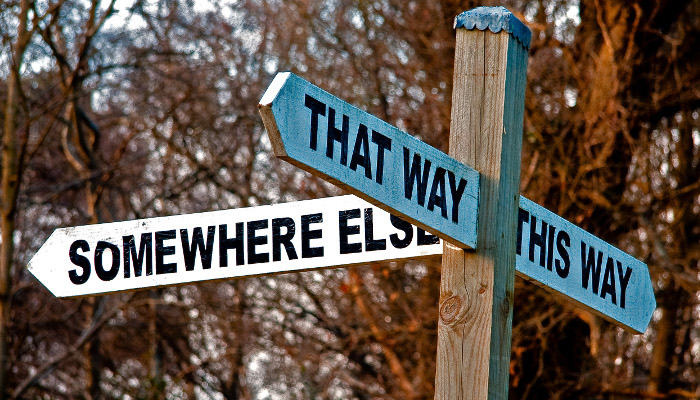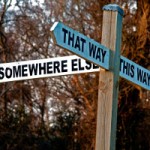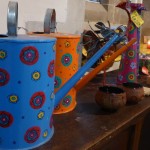Sermon preached by Cedric Blakey on 20 December 2015 – Advent 4
Alan McManus: Both Sides Now – Scotland and England

Reading Pádraig Ó Tuama’s In the Shelter: finding a home in the world, about telling stories in the shelter of the Corrymeela community, in the place he problematises in a poem’s title as ‘[the] north[ern] [of] ireland’, I think of an undergraduate essay I wrote for a course of Practical Theology, in St Andrews University in the late 1980s (a decade or so before the Good Friday Agreement was signed in 1998). In it, I identified the phenomenon of what is now commonly known in critical theory (and may have been then, but not to me) as ‘multiple selves’.
I wrote of categories of identity, of Us and Them, which were problematic because historically, culturally, linguistically and/ or ecclesiastically, they included the identity of the Other they attempted to exclude:
‘Protestant’ being rooted in the Pre-Reformation Church, which ‘(Roman) Catholic’ claims also to be in unbroken continuity with and which also, at Vatican II, accepted much of the protest of Martin Luther, 400 years on; ‘Scot’ coming from and returning to ‘Ulster’, territory which does (not) include Donegal and which is (not) ‘Irish’ and is also (not) ‘British’ – another humdinger of a category that can designate anything from ‘Brythonic Celt’, through a successful ‘Welsh’ (Tudor) exercise in propaganda, to ‘English’ and ‘Commonwealth’ and ‘United Kingdom’.
Each phrase that I have written in the above paragraph is so problematic that it would be quite reasonable to argue that it is a downright lie. And yet it tells a truth. I have not attempted to draw out all instances of contradiction and connection, overlap and oversight that are possibilities among all these categories of identity.
My point in the essay was that the only way to peace is to accept the reality of this blurring of identities and to tell our stories. Argument of the ‘you’re wrong so I’m right’ variety can’t do that. Mostly because it depends on asserting and maintaining rigid categories of ‘you’ and ‘I’, of ‘us’ and ‘them’. (Of course I’m thinking of David Hare’s wonderful play, Us and Them, and if you haven’t in your life yet seen a youth theatre group perform it then do so.)
The pain of the Referendum on Scottish Independence this year, before, during and after, was one which is not supposed to exist. We don’t have a word for that which, ‘over there’, (another quote from Hare) has been called Trioblóid/ Troubles, which Ó Tuama explains means ‘Bereavements’. Of course it really has meant that in both languages.
We don’t have a word in English, or in Scots, or in Scots Gaelic, or in any of the other indigenous languages of these islands for the Troubles between ‘English’ and ‘Scot’. We have had no way to express this pain – and because we can’t express it, the pain has nowhere to go. The attempts of ‘No’ voters to come to reconciliation have met with inchoate rage from those who are ‘Still Yes’, a rage that cannot find adequate words to express itself as there is no common ground to argue over; the decision to vote ‘Yes’ in the first place was met with some of the same feeling, mostly on the internet and over the border, but here in Scotland this decision, when not shared, was met with much sorrow, with hurt and with incomprehension.
A good friend of mine, a good friend and a good man, said to me, in a pub on Great Western Road, in Glasgow, at the height of it all, when I was full of the disenfranchised of Maryhill waving banners and having the hope of making a difference, and frustrated with him for not getting it: ‘it really pains me when you talk about Scottishness as a club, of which I am not a member’.
I was simultaneously ashamed, and annoyed with him for being awkward. He’s like Màiri Mhòr nan Oran, Big Mary of the Song, who was banned by her dour minister from singing inside the house and outside the house. Màiri Mhòr stood in the doorway of her house and sang. My friend is like that, awkward, and I want to trace his genealogy and add up the years he’s spent ‘here’ or ‘there’ and come to a decision: is he or is he not Scottish? But then I’d have to do that for myself, and that would be unnerving.
During the year I spent in California 1990-1991, while not marching with banners proclaiming NO BLOOD FOR OIL! (if the protestors kept them, they’ll have been well used since) I participated in groupwork on prejudice and liberation. Focussing especially on the negative media portrayal of Islamic/ Middle Eastern men (watch Sex in the City 2 for an instance) I discovered my deepest racial prejudice. I was anti-English. Which was awkward, since my mother grew up (when not evacuated to her mother’s people in the West Highlands) in a village that Miss Marple would have felt at home in, my grandfather was born within sound of Bow Bells and – though his father came from Germany and, perhaps, generation upon generation, from Israel – his mother was from East Anglia and her surname means ‘home’.
We need to listen to each other, both sides, now, in Scotland. Not rush to hug each other in a false reconciliation which only continues to ignore the pain which is unspoken since officially it doesn’t exist.
‘(Still) Yes’ voters need to hear how it feels to have the door of this exclusive club called ‘Scottish’ shut in your face, the shock and hurt of your dearest friends and neighbours and indeed family wanting you and yours politically over the border like Jock O’Hazeldean and the lady that was(n’t) his. Sometimes very aggressively. Sometimes violently. Sometimes thoughtlessly. I was shocked, then ashamed, when an old friend from Barbados was chipping in with his hopes and fears (for ‘No’) over the internet. ‘What’s it got to do with you?’ I asked him. He told me. I’m middle-aged, with more degrees than sense, and had ignored the fact (fiction) that Barbados is ‘British’.
‘No’ voters need to hear how it feels to constantly correct not just ‘foreigners’ but our southern neighbours, even living amongst us, when they conflate ‘England’ and ‘Britain’, again and again and again. Still. How it feels to be tongue-tied in yer ain tongue, which no teacher, correcting you, again, ever told you contained words footnoted in Shakespeare (for monoglot English speakers) incomprehensible in Oxford but instantly recognisable from Friesland to Scandinavia. How our myth of oppressed national identity that draws a clear line from the Clearances by anglicised lairds to the closure of the steelworks at Ravenscraig in the wake of the Thatcher years is so problematic that it would be quite reasonable to argue that it is a downright lie. And yet it tells a truth.
In Hare’s play, it gradually becomes reasonable to draw a line of separation, to mark it with a string, a fence, ever higher, finally, of course, with a wall. In Ó Tuama’s book, he quotes the Irish saying: Ar scáth a cheile a mhaireas na daoine/ It is in the shelter (shadow) of each other that the people live. He draws out the ambiguities of scáth among which, in English, are the idea of living in someone’s shadow, and of the shadow self. Embracing, accepting and celebrating my Englishness, overlapping and intermingling with my Scottishness, has been a great joy, a great challenge and a great liberation. I feel more whole, I also feel far more confident in asserting the Scots language. One does not preclude the other. I don’t assert the English language as there’s been too much of that already.
If we are to heal, if we are to live together in 2016 and beyond, in harmony, in whatever political constellation we democratically decide on, we need to come out from under each other’s shadow, and enter into our own. We need to shelter each other’s stories because even if they contain lies they tell truths. We need to stop arguing, stop denying our troubles and start sharing our heartfelt pain through telling our stories. Both sides, now.
Photo Credit – Simon Greig CC Attribution-NonCommercial-ShareAlike 2.0 Generic
Sermon preached by Prof John Riches on 13 December 2015 – Advent 3
Sermon preached by Cedric Blakey on 6 December 2015 – Advent 2
Photogallery from the World Christmas Fair
This week’s magazine entry is a photogallery of the stalls at the World Christmas Fair.
[soliloquy id=”7685″]
World Aids Day Forum with Andy Winter
Sermon preached on 29 November 2015 by Kelvin Holdsworth
Regular Midweek Services
Monday to Saturday
Morning Prayer is said at 9.30 am every day in the oratory. (On some feast days this is replaced by a communion service in the chancel).
11 am every Thursday
There is a Eucharist at 11 am every Thursday morning in the chancel followed by refreshments in the synod hall.
Deryl Davies: Giving Thanks
When thinking of the American (U.S.) Thanksgiving holiday, certain iconic images come to mind: Of families gathered around dinner tables laden with roast turkey, stuffing, and pumpkin pie; parades with marching bands and giant helium balloons; (American) football matches on television; and Pilgrims in tall black hats sitting down to the first Thanksgiving feast. As important and real as these images may be, I think filmmaker John Hughes captured something of the spirit of Thanksgiving in a tug-the-heartstrings film he made in the 1980s called Planes, Trains, and Automobiles. If you’ve seen that film, you’ll remember that the plot centers on a marketing executive, played by Steve Martin, who is trying to get from New York to Chicago in order to have Thanksgiving with his family. He runs into all kinds of obstacles during the busiest travel week of the year – from snowstorms and cancelled plane flights to broken down trains, burned out rental cars, and an uncomfortable ride in the back of a long haul lorry. His constant, and unwanted, companion along the way is a large, socially clumsy, loquacious shower curtain ring salesman played by John Candy (a Canadian!). Martin’s character spends the bulk of the movie trying both to get home and to get rid of Candy’s salesman. But when Martin finally does get home for Thanksgiving, a light bulb goes off; he realizes that his erstwhile, bothersome travel companion has no home to go to, and so he invites him into his own. The movie ends with Martin’s character introducing Candy to his wife, while a Thanksgiving feast awaits them in an adjoining room.
For all its Hollywood trappings, I think director Hughes captured something important about Thanksgiving in his film. It is a time of family celebration, of eating wonderful food and enjoying activities together, but also of sharing and of welcoming others. That is the often overlooked story behind the first Thanksgiving (or one of the first – there is some debate). That took place in the village of Plymouth, Massachusetts in November 1621, when a few score English settlers, all who were left of a larger group that had sailed from England the year before, sat down to celebrate a successful harvest – a necessity for their own survival. They invited their indigenous neighbors, of the Massasoit tribe, to join them for three days of feasting and thanksgiving. Sometimes forgotten is the fact that the colonists’ own survival had depended largely upon these neighbors, who taught the starving colonists how to cultivate corn, catch fish, and locate edible plants. Their feast was a celebration and a thanksgiving, both to God and to the neighbors who had helped them survive. If their aim was to plant a ‘shining city on a hill’, as Puritan leader John Winthrop was to say a few years later, the native peoples had helped them do it. I am still struck, as I was as a child, when I see a painting imagining that first Thanksgiving: The Puritans in their black garb, tall hats, and brass buckle shoes sitting beside indigenous people with their animal skins, colorful jewelry, and hair feathers. It’s a strange and almost unimaginable combination, and that’s the wonder of it.
The English colonists were, of course, practicing an ancient tradition of giving thanks for God’s provision, which often included periods of fasting. They were to do it again two years later, and after that, many of the original colonies held annual days of thanksgiving, sometimes following upon periods of fasting. In 1789, the first U.S. President, George Washington, called upon the new nation to hold a day of thanksgiving for the successful end of the war against (You Know Who) and the ratification of the U.S. Constitution. Later presidents followed in similar suit. But it was not until 1863 that Thanksgiving became an official national holiday. Then, in the middle of the American Civil War, President Abraham Lincoln issued a declaration calling for a “day of Thanksgiving and Praise” upon which Americans could thank God for the bounty they received; “commend to his tender care” widows, orphans, and others who suffered losses in the war; and implore the Almighty to “heal the wounds of the nation.” The holiday was fixed on the fourth Thursday in November, which it remains today.
Although a lot of the original meaning, and meanings, of Thanksgiving have become clouded – popular references to ‘Turkey Day’ and presidents pardoning select members of the species, for example – the holiday is still seen as a time to reach out to others. Volunteer activities are important, and many churches and social service organizations hold food drives, deliver meals to the homebound, and host Thanksgiving dinners for the homeless and those with little means. While the needs for food and companionship certainly extend beyond the holiday itself, Thanksgiving provides some Americans with a first experience of helping others in need and (probably contrary to marketers’ intentions) highlights the discrepancies between the ‘haves’ and the ‘have nots’. Among my favorite Thanksgiving memories is a time that I took my (understandably reluctant) young children to deliver meals to some homebound persons living in social housing. Some of them identified as Christian, at least one man was Jewish, and others may have had no religious affiliation at all. That didn’t matter. But the look on their faces when they saw my children at their door is one I, and I hope they, will never forget. To my mind, Thanksgiving at its best is a shadow of that inclusive heavenly banquet where all are fed at God’s table.
* * * * * *
But back to Hollywood and popular conceptions of the holiday. The 1980s must have been a big decade for films about Thanksgiving, because Woody Allen also featured the holiday in one of his best movies from that period, Hannah and Her Sisters. You may remember the storylines which connect various characters in the film to Hannah (Mia Farrow), the center of a dysfunctional extended family that relies on her steady presence. In a narrative framed by three successive Thanksgiving gatherings in Hannah’s New York apartment, we follow the characters as they deal with existential crises including adultery, career disappointment, family divisions, and the meaning of life itself. The shared Thanksgiving meal marks the passage of time and reminds the characters (and the viewer) that, for all their failings – and they are significant – these people are a community. The annual gathering reinforces that fact and makes it real, without dismissing the issues that threaten their common identity.
So, this Thursday, 26 November, travelers across the United States will be rushing home by any means possible to sit down with their families at tables laden with turkey, cranberry sauce, and pumpkin pie; American-style football matches will be broadcast non-stop on television to millions of viewers; bands will march and play, tugging huge balloons in their wake; bleary-eyed shop workers will be preparing for the massive Black Friday rush; and the president will pardon another lucky member of the turkey race. And many people – among them, many people of faith – will be giving thanks for what they have received and sharing it with others. Whether or not the attendees of that first Thanksgiving in Massachusetts ate turkey, cranberry sauce, or pumpkin pie (and it is doubtful that they did), they left us an important image of welcome, community, and sharing. Whatever else Americans remember on this day, we should be thankful for that.




